What’s the ultimate purpose of Amazon listing optimization? It’s to compel consumers to buy your products. Amazon listing optimization helps differentiate your brand and products so that you garner the most visibility against your competition. Creating a persuasive Amazon listing optimization in 2024 does not have to be an intimidating process. With some great resources in your tool belt, you can craft a conversion-worthy listing. In this guide, you’ll learn everything you need to know about Amazon listing optimization, from selecting your target market to keyword research, copywriting, and more.
Table of Contents:
-
What is Amazon product listing optimization
- What to avoid in listing optimization
-
The first step of Amazon listing optimization
-
What other steps are required to craft an Amazon list
-
Why crating a buyer avatar is essential to Amazon listing optimization
-
How to harness the power of e-commerce copywriting in your Amazon listing
-
What you need to know about Amazon listing optimization
-
What is Amazon SEO
-
How to optimize the Amazon title
-
What are the backend search terms
-
How to create conversion-worthy Amazon bullet points
-
Maximizing Amazon sales with ChatGPT
-
How to tell your brand story in the HTML description
-
Amazon FBA listing optimization: Images are everything
-
What is A/B testing, and how can it benefit Amazon listing optimization?
- Final Amazon listing optimization tips
Read the full guide to learn everything you need to know about Amazon Listing Optimization in 2024.
What is Amazon Product Listing Optimization?

Amazon listing optimization, also known as Amazon search engine optimization, is the process of optimizing the Amazon product detail page to assist in increasing indexing and organic rank across the search results on Amazon. By optimizing a listing’s SEO and improving copywriting and imagery, Amazon sellers may gain a better shot at boosting visibility and sales on the world’s largest online marketplace. Optimization is helpful, especially as competition on Amazon increases.
What To Avoid In Amazon Listing Optimization
A cookie-cutter approach is never a good idea when building a brand, especially on Amazon in 2024. Sellers must start with a great product and pursue a 365-degree marketing and advertising initiative to unlock the best results. Here are some quick tips for what to avoid:
- Not leveraging SEO in your title
- Not following Amazon’s Code of Conduct
- Making FDA or pesticide claims
- Misleading customers
- Faulty products
- Poor branding
- Confusing, hard-to-read copywriting
- Feature-focused images without people or user generated content
- Lack of comparison to the “other guys”
- Weak keyword research and placement
Continue reading to learn how to optimize your Amazon listing the write way in 2024.
The First Step of Amazon Listing Optimization
The first step to Amazon product listing optimization is to create a detailed product spec sheet. This info sheet is not the typical info sheet you’d get from your manufacturer. Start by performing a scratch and sniff of your product, so you can understand its pros and cons.
Step 1: Product Scratch and Sniff – How can you relay the benefits of your product if you don’t actually sample and test your product? You’d be surprised by the number of sellers who don’t order product samples and do not know their product’s full scope of features or benefits. Review product packaging and inserts and pull apart every aspect of the manufacturer’s user guide and warranty. Try your product for a week or two, and note as many positive and negative attributes as possible. You want to know how well it functions and where improvements can be made.
What Other Steps Are Required to Craft An Amazon List?
After dissecting your product its time to look at the other steps required to draft an Amazon listing.
Step 2: Convert Features to Benefits – In case you forgot, here is the difference between a feature and a benefit. A feature is a part of your product. For example, A hot air brush is made with three heat settings. A benefit is an outcome associated with your product. The hot air brush smooths hair and dries hair faster.
In a spreadsheet, detail as many features and benefits that come to mind. Don’t forget to review competitor listings. Use a feature and benefit converter like the one we created in the image below to help you understand how the features of your product benefit your ideal customers.

Figure 1.0 Christina Ink: Features and Benefit Converter
Step 3: Research the Customer Reviews – Record as many reviews from your top 3 to 5 competitors. Saving all of this information in one well-organized spreadsheet will help you understand areas of your product you may seek to improve over time. Helium10 offers a great feature where you can analyze a product’s review and question history using the Chrome extension with a press of a button.

Fig 1.1 Helium10 Review Insights
Step 4: Analyze Customer Questions – Questions and answers are vital to Amazon listing optimization and can make a big impact on your ROI. If you address a common question in one of your top 3 bullet points, shoppers don’t have to hunt too far for accurate information and product details required to make a purchase decision.
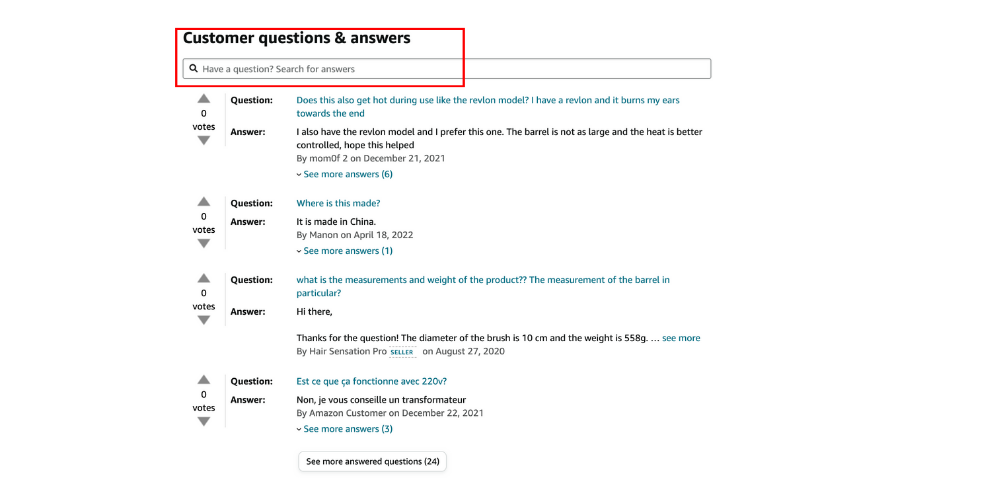
Figure 1.1 Amazon Customer Questions found on Amazon.com.
[Feeling overwhelmed? Relax, we got you! Christina Ink offers full Amazon listing optimization with a range of services, including advanced SEO, compelling copywriting, Amazon Images, A+ Content, and more. Focus on what matters most in your Amazon business and let the experts at Christina Ink handle all your Amazon listing optimization needs. Contact us today for a free Amazon listing audit.]
Why Creating A Buyer Avatar Is Essential to Amazon Listing Optimization
Having a solid grasp of some basic marketing strategies will help you understand your audience. Before you begin to write your Amazon list, you need to clearly understand who exactly you are marketing your brand and products to. Creating a buyer avatar is a critical step in your branding and Amazon listing creation, but frequently sellers fail to carve out their specific audience.
How to Create a Buyer Avatar:
- Who? Give your avatar a name.
- Education? Did they attend a post-secondary institution? What type?
- Work? What do they do for work?
- What is their income bracket?
- What are their content interests and social media habits?
- Are they married, single, or divorced?
- Do they have children?
- What are their hobbies?
- What are their content preferences?
- What social media channels do they prefer?
- What are some common pain points they openly talk about online?

Figure 2.0 Sample buyer avatar outline.
Spend time in Facebook groups, search Google Trends and Answer the Public, and read similar product reviews to perform crucial market research about your audience. Pay close attention to the questions they ask about similar products, their lifestyle, their pain points, how they converse online, and their demographics. Analyzing this data is the key to unlocking your ideal buyer so you can craft content that resonates with them the most.
How to Harness the Power of E-Commerce Copywriting in Your Amazon Listing
Now is the time to craft foundational messaging and a unique brand story that stands out on Amazon and stands the test of time. To do that, you’ll need a few pieces of vital foundational copywriting. Below you’ll find some core pieces of copy you can leverage to create a better connection with buyers on and off Amazon.
- #1 USP and Value Proposition – Clearly define your Unique Selling Proposition and your Value Proposition. What are the benefits to consumers of your brand and product? Try using this equation, and add a few power words to refine your USP: [Product] helps [buyer avatar] solve [problem] and get [value] in [what differentiated way].
- #2 Mission Statement: You mission statement expresses the core purpose and long-term objectives of your brand beyond just making a profit. Outline the reason your brand exists, the positive impact it aims to make on the world, and the values that guide its decisions.
- #3 Brand Tagline or Slogan: A slogan is a memorable phrase that encapsulates your brand’s essence and resonates with your audience. Craft a short and impactful statement that captures the spirit of your brand and leaves a lasting impression. Don’t forget to consider your audience and mission when crafting this core piece of copy.
- #4 Brand Story: A brand story helps narrate your brand’s history, values, and journey, creating an emotional connection with your audience. Develop a compelling narrative that traces the origins of your brand, the challenges you’ve overcome, and the values that drive your actions.

Let’s Recap:
Things you’ve learned so far:
- What is Amazon listing optimization
- What to avoid in listing optimization
- The first steps of Amazon listing optimization
- What other steps are required to craft an Amazon listing?
- Why creating a buyer avatar is essential to Amazon listing optimization
- How to harness e-commerce copywriting in your listing
What You Need to Know About Amazon Listing Optimization

Figure 2.1 Amazon style guides.
Now that you understand the difference between Amazon’s Code of Conduct and the Amazon Style Guides, we’ll briefly touch on Amazon SEO.
What is Amazon SEO?
The Amazon algorithm uses a scorecard to determine where your listing will be shown. The combination of a great product, advanced SEO, relevant highly searched keywords, healthy in-stock rates, stable sales, and a positive conversion rate help score your listing positively in the algorithm to boost your product’s visibility. When all factors come together to produce positive results, this is known as the Amazon flywheel effect. Advanced Amazon SEO and compelling copy must work in combination to prove the best results
A great Amazon listing has highly searched and highly relevant keywords throughout the front and back of the listing. After you’ve done your research and prepared a list of the top most relevant, highly searched keywords, you’ll want to organize them by importance. Label the most essential keyword on your list at 100% , all the way down until the least important keyword as a far lower percentage. Always consider these factors in Amazon keyword research: relevancy, search volume, competing number of products, and position rank of your competitors.
How To Optimize The Amazon Title
The Amazon title is the most important driver of SEO. To rank and index in Amazon search, you need the best keywords, along with great copywriting, images, and a well-differentiated product. Did you know that in 2022 alone, over 5 billion people shopped on mobile in the USA? Optimizing your Amazon listing for mobile is a crucial step; here are some mobile title optimization tips:
- The title on mobile truncates around 80 characters. Place the most important keywords first to avoid truncation
- Add critical specifications after your brand name, such as pack quantities, vital measurements, and important product attributes
- Avoid clickbait; customers will click on your listing and scroll away
- Make it readable. You have seconds to get a mobile shopper to click on your lisitng rather than be distracted. Use a couple of power words, and make it count.
Refer to the Amazon Style Guides for the number of allowable characters in the title. The most common Amazon title length is 200 characters, but that can change slightly depending on your category. It’s a good idea to refer back to the style guides to ensure your bullet points and description are in line with Amazon’s preferred styling. The style guides are found in your Amazon Seller Central and detail the listing parameters specific to your category of products.
The first 3 to 5 words of your Amazon product title are the most crucial. Double-check that you have the appropriate keywords in this crucial area and avoid trigger words. Avoid the use of commas in the title, as it’s believed that the algorithm does not split words where there are commas. Dashes are more acceptable, but remember to place a space before and after each dash. Refrain from using choice wording such as Best, Free, Bonus, etc.
Here’s a title template to help you get started: Brand Name [Brand Product Name] [Main Keyword] [Pack Quantity]- [Relevant and Highly Searched Keywords] [Descriptive Attributes] – [Size And Color]. Example Title: Beauty Babes – Hot Air Brush – At Home Blowout Straightening Comb – Hair Dryer – Dryer for Women – Hair Dry Hot Air Brush – Great for Salons and At Home w/ Ion Technology Ceramic Plates – Large Handle
The title should be easy to read and include at least one power word to entice the reader so long as that word is within the style guides and code of conduct. Having a readable title can significantly affect the number of clicks and sales your listing receives.
What Are the Backend Search Terms?
Backend search terms are exactly as described; search terms are located in the back end of your product listing where upload takes place. The Backend search terms are an additional SEO section to help boost product visibility. This area is the best place for remaining relevant keywords you could not fit into the front listing. Don’t include commas or plural forms, or trigger words. Place as many relevant keywords in the backend search terms as possible, and remember that you can update these words during holidays and different seasons. Consider adding search terms in different languages, such as Spanish and French, if relevant.
The debate about characters versus bytes in the backend search terms is a hot topic in the Amazon community. Amazon states that backend search terms are counted using bytes which differ from characters. If you’re savvy, you can fit a few more search terms in this area with this vital Amazon SEO hack. Otherwise, you can fit up to 239 to 245 characters in this area.
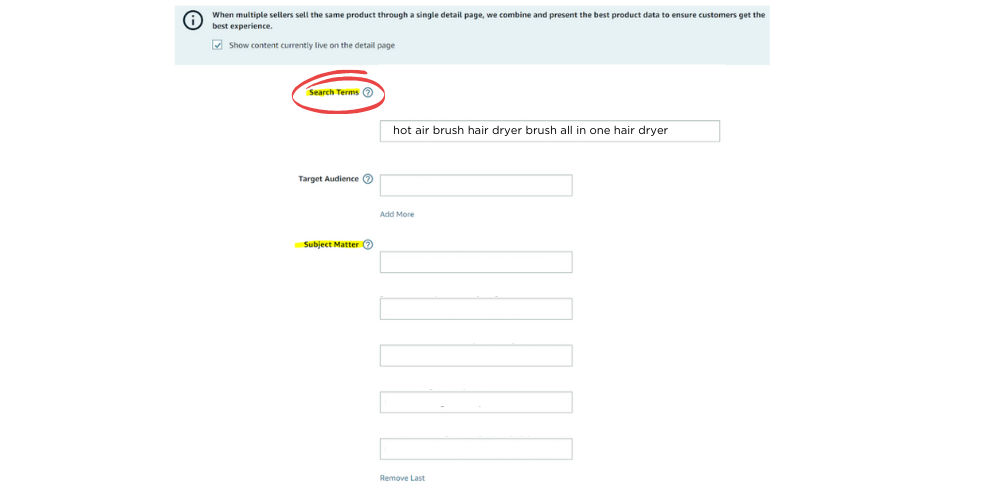
Figure 2.2 Amazon backend search terms section.
How to Create Conversion-Worthy Amazon Bullet Points
Each category offers a different number of Amazon bullet points. The standard number is five, but some categories may see up to ten bullet points. Check with the Amazon style guides prior to writing each bullet point for the correct number for your category. It’s important not to have too long or too short bullet points so that your listing can properly index and rank. Amazon states that it only indexes the first 1000 characters of all 5 bullet points. Consumers will scan content so its also important to ensure all bullet points are roughly the same length. The visuals of text matter for both mobile and desktop shoppers.
Another crucial factor of Amazon listing optimization is that your product listing must be readable. Your Amazon listing should be persuasive and readable at a grade 7 to 8 level. Don’t use redundant me-too copy, and avoid complicated words that come from your internal team or manufacturer. If a potential shopper can’t read the copy in your listing, they are almost certain to scroll away instead of add to cart. Before you get overwhelmed with keywords and writing compelling copy, start by writing without keyword placement. Add keywords after you’ve created each bullet point, and ensure they are readable in each sentence.
- Bullet #1 The first Amazon bullet point should highlight your product’s unique selling proposition and biggest product benefit. Emphasize how your product solves consumers’ problems and potentially transforms lives.
- Bullet #2 & 3 Highlight more product benefits and aim to create a comparison bullet point that highlights why your product is the better option. Don’t call out other brand names in these comparisons, and always avoid making any false claims. Tell customers how they will benefit from your product and seduce them with persuasive statements and influence. A compelling copy can make all the difference in your sales. Example of a good Amazon bullet point: The Hair Dryer You’ll Wish You Bought Sooner – We understand the painstaking process of hair drying, and that’s why we crafted our premium Beauty Babes hot air brush to speed up drying time and add that smooth, sleek shine back to your beautiful hair. Drying doesn’t have to disappoint with Beauty Babes.
Check out this example of an Amazon listing with benefit-focused copywriting. Notice how the content is positioned around how the customer’s life will change and benefit from purchasing this product.
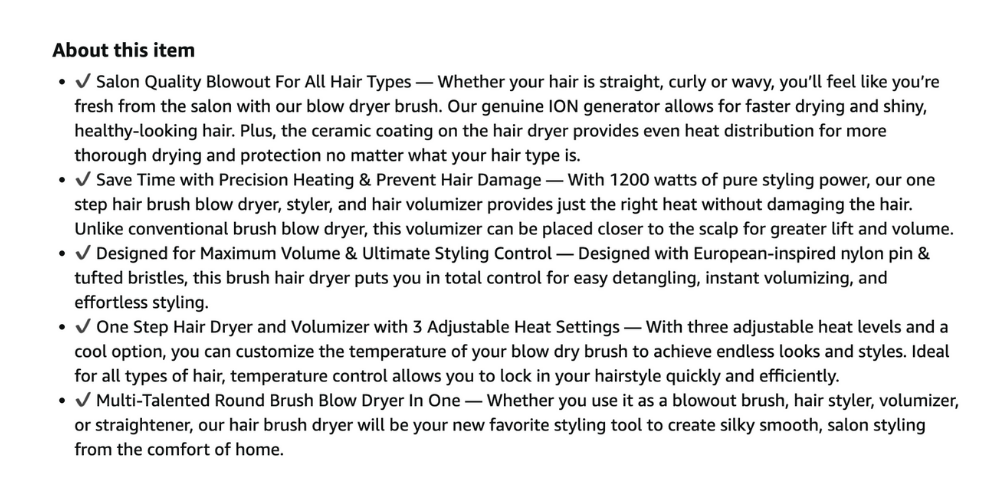
- Bullet #4 Don’t forget to highlight the value a potential buyer may receive in buying your product. Use bullet four as an opportunity to call out how great a seasonal item, gift, or favorite holiday surprise your product would make. For example, The Best All-In-One Drying and Styling GIft – Competitor products don’t offer the same great value that Beauty Babes offers. In your purchase today, you’ll get our famous hot air brush, a detangling brush, and a stunning black felt storage bag, all in one great gift set just in time for the holidays.
- Bullet #5 Use bullet 5 to highlight unique brand identifiers like made in the USA or that your startup stands behind its products. Spotlight how your brand is different, confirming your USP statement. Avoid generic overused guarantee statements. Don’t offer a different warranty or guarantee statement in the fifth bullet point as Amazon sellers commonly do. Doing so rivals Amazon’s own guarantee. You can, however, try using statements like Risk-Free. Be mindful of making false claims, and avoid using any trigger words that could potentially flag your listing for pesticides, prohibited product claims, or FDA warnings. These violations can be serious, challenging, and time-consuming to overcome.
Here are a few pesticide trigger words to avoid anywhere in your lisitng. Review Amazon Seller Central for a detailed list.
- Non-toxic
- Anti-microbial
- Anti-bacterial
- Cancer Curing
- Alleviates Depression
- Stroke Prevention
- etc
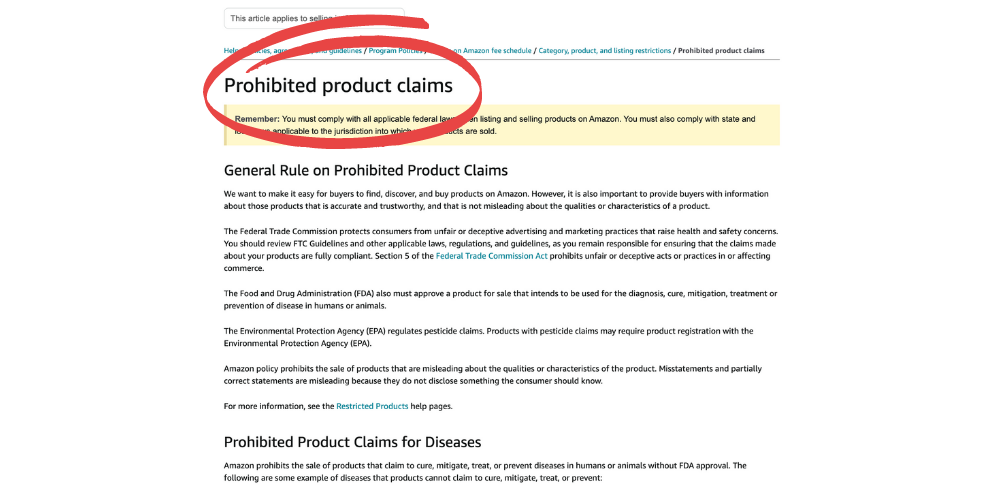
Figure 3.0 Amazon prohibited product claims.
Once you’ve crafted persuasive and compelling bullet points, you can start plugging in your keywords. Always maintain readability but try to keep your keyword phrases intact.
Maximizing Amazon Sales with ChatGPT
A powerful way to optimize your listing is through the use of Artificial Intelligence (AI). ChatGPT empowers Amazon sellers to efficiently create persuasive bullet points for their product listings. Here’s some helpful information on how to leverage Amazon ChatGPT prompts for enhancing your Amazon bullet points and product descriptions:
- Input Vital Product Information: To initiate the ChatGPT process, you’ll need to provide essential information about your product, target audience and brand. Details such as the product category, buyer psychology, and any specific selling points you wish to highlight are essential. This information serves as the foundation upon which ChatGPT crafts tailored bullet points for your unique product. After updating this information ask ChatGPT to clarify it understands the directive before writing. Doing so helps ensure you’re on the same page with the directive.
- Concise and Informative Bullet Points: Leverage ChatGPT to create concise yet informative bullet points that seize the attention of potential customers and follow Amazon’s requirements. Before generating any content, be sure to rely important bullet point specifications such as: “ensure each bullet point is between 200 and 250 characters”, or “avoid making health claims,” etc. This sets the stage for your listing to meet Amazon’s code of conduct. Keep in mind ChatGPT will not know all of Amazon’s requirements. It’s essential to review any outcomes for accuracy, claims, and triggering content prior to uploading on Amazon.
- Benefit Emphasis: One of the great skills of ChatGPT is to turn features into benefits. Describe using specificity your products biggest features and ask ChatGPT to transform your input to benefits. ChatGPT can assist in formulating bullet points that employ persuasive language to drive conversions. Try leveraging AI to write open-loop hooks for the start of each bullet point, piquing shopper curiosity and enticing them to click add to cart.
- Addressing Customer Pain Points: An essential element of effective marketing is addressing the pain points of your target audience. ChatGPT is proficient at generating bullet points that directly speak to these pain points and demonstrate how your product offers a solution. For example, if you’re selling a posture-correcting chair, ChatGPT can create a bullet point such as, “Bid farewell to back discomfort with our ergonomically designed chair that promotes healthy posture.”
- Stand Out from Competitors: In the fiercely competitive landscape of Amazon, it’s crucial to spotlight what makes your product unique. ChatGPT can help you craft bullet points that set your product apart from similar offerings. Have ChatGPT rewrite your competitors bullet points and see what insights you can glean from the results. You’ll have a better understanding of your competition, and exact ways to differentiate through copywriting alone.
- Edit and Refine: Use ChatGPT to scan your results for readability, and grammar. Always cater your Amazon bullet points to the average reader. Before uploading your product listing, it’s essential to review and refine it to ensure it meets Amazon’s code of conduct. Never rely on ChatGPT without double checking it’s work. AI has come a long way, but blindly relying on AI could cost you your Amazon selling ability if not careful.
By harnessing the capabilities of ChatGPT, you can save time and effort while ensuring your product listing adeptly communicates your product’s distinctive features and benefits to potential customers. Do we think you can use ChatGPT to write an entire Amazon listing? Yes and no. Be prepared to copy-edit your results, and lean on your ideal buyer avatar to ensure your content speaks to the right audience.
How to Tell Your Brand Story in the HTML Description

The Amazon product description is the area at the bottom of the product detail page following the 5 bullet points where you’ll find additional space to craft your brand story product details. Alternatively, this space can also capture the Amazon Brand Story and A+ Content sections if you are a brand registered seller. If not, you’ll create a written description which we call the brand story. HTML code is a specific type of formatting code Amazon requires for you to properly upload your description in the back end. Amazon did mention early this year that it would remove HTML formatting, but as of Dec 2022, we have not seen that change. A major change to the HTML Description came into place in the summer of 2021. Excessive HTML code is not permitted; only line breaks (<br>)
Avoid formatted HTML text such as:
- Bold
- Italics
- Numbers and Bullets (#1)
Tell a story in the Amazon product description to tell shoppers a bit more about your brand, your mission and vision. Start the description with an open-loop hook to pique curiosity. The description is a great place to restate prime benefits shoppers can’t live without. Finally, add a how-to, tips, or an FAQ section to addresses commonly asked questions so shoppers don’t have to scroll away to unlock valuable information.
Amazon FBA Listing Optimization: Images Are Everything
You can find Amazon product image requirements by searching Amazon images in Amazon Seller Central. Always follow the proper size guidelines (2000 x 2000), use a white background, and be sure to use clear and concise infographics to help emphasize your product’s biggest benefits. Here is a brief breakdown:
- The product must fill at least 85% of the image.
- Images must accurately represent the item listed.
- Images can’t display Amazon logos, trademarks, or words that contain Amazon, Prime, etc.
- Images must not include any badges used on Amazon, including the Amazon’s Choice or Premium Choice badge.
- Images must be in focus, professionally lit, and with realistic color, with no pixelation or jagged edges.
- Images can’t contain nudity or be considered sexually suggestive or inappropriate.
- Pixel dimensions of at least 1000 or larger in either height or width.
- JPEG formats are preferred, but TIFF and GIF file formats are accepted in sRGB or CMYK color mode.
- File names must contain the Amazon ASIN, followed by a period and the file extension. No spaces, dashes, or additional characters are permitted in the file name.
When it comes to graphic design, there are several tips that can help you understand what makes a good quality Amazon image and what does not.
#1 Follow your brand guide – One of the most useful and under-utilized Amazon graphic design tips is to carry your brand guide across your website, social media, and Amazon listing. Following your brand guide helps you build brand authority and helps build brand recognition.
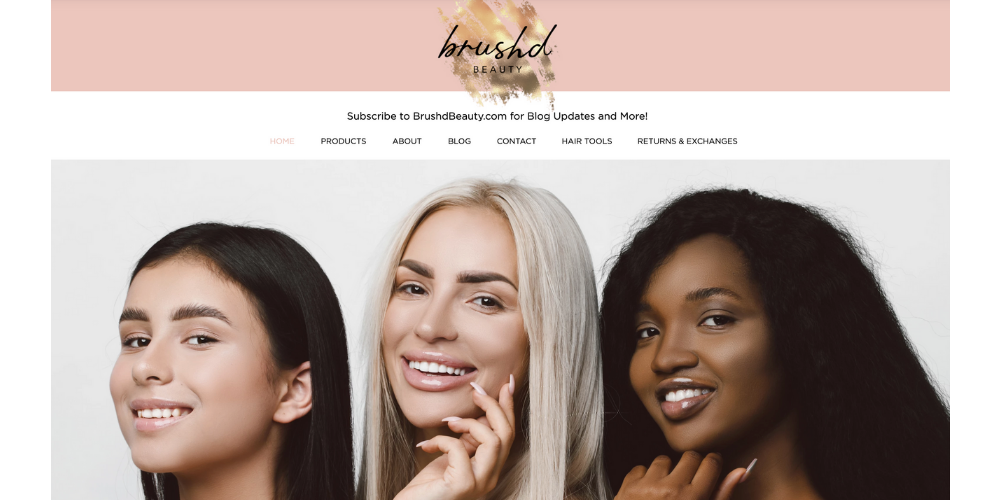
#2 White space – Balancing white space with the elements of graphic design is paramount to a design’s appeal. Use just enough white space so that the image is not cluttered and therefore well balanced.
#3 Lifestyle images – Lifestyle images help draw attention to the massive benefit using your product holds for potential buyers. Shoppers should be able to see themselves in your content so they resonate with your visuals. Try leveraging user generated content, as UGC Is effective and affordable.
#4 Infographics – Your Amazon images should include 1-3 infographics to highlight the unique features of your product. Ensure your infographic contain large readable text and help make important features stand out.
These Amazon graphic design tips should help guide you in crafting stunning graphics for your Amazon listing.
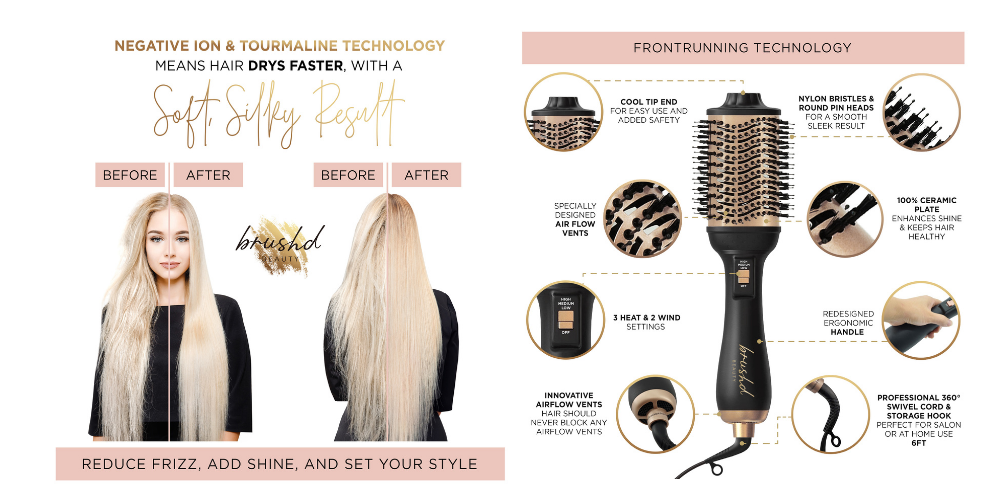
Figure 4.0 Sample Amazon infographics.
What is A/B Testing and How Can it Benefit Amazon Listing Optimization?
Split testing helps people determine which pieces of their content are more likely to convert in sales. Some examples of items people may choose to split test are the Amazon listing images, the Amazon title, bullet points, A+ Content, and Amazon Brand Story. You’ll employ split testing services that lend look-alike audiences to help you determine which options may prove the most successful.
Try to remove any prejudice you may have towards your listing when provided with your split-testing results. An Amazon listing is not about you; it’s about conversion, so heed the results with seriousness and make solid business decisions based on the information provided.
Amazon Lisitng Optimization For the Win, Now and in the Future
In today’s climate a robust marketing strategy, a highly differentiated product, and a unique brand persona will distinguish lasting, profitable brands from me-too copy cats that don’t last.
Final Listing Optimization Tips:
- Research is the foundation of listing optimization.
- Editing ensures the language is native to the marketplace and free of literals.
- Review your backend to ensure it meets the Amazon policy and requirements.
- Record any changes Keep tabs on updates to your listing in an on-going spreadsheet so you can understand what is working and what isn’t.
- Backend search terms. Update this area regularly with highly relevant and high search volume terms depending on the season or holiday. Don’t forget to add different languages like Spanish or French.
- Emojis are technically not within the Amazon Style Guides, but you will see that many sellers choose to use them in their bullet points. You’ll have to decide but we recommend staying within Amazon’s policies.
- Review brand analytics to unlock potential keywords to dominate your competition.
- Think about an exit from the time you start your business. That means healthy books and wise business decisions.
Looking for expert optimization help? Look no further…
Check out our Amazon Listing Optimization Case Studies to review our success stories. Contact us today for a free Amazon listing audit. What optimization tips can you share to help other sellers? Comment below and let’s help each other out.

LIKE THIS ARTICLE?